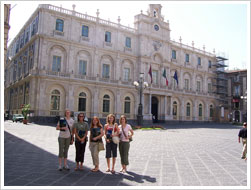 Walk into your child’s preschool classroom and you will find a large, colorful room divided into carefully planned interest areas. It will be filled with bright, primary colors and a variety of materials for your child to manipulate, explore, snuggle, play with, and share. The room is especially designed to encourage your child’s natural curiosity and desire to learn about her world.
Walk into your child’s preschool classroom and you will find a large, colorful room divided into carefully planned interest areas. It will be filled with bright, primary colors and a variety of materials for your child to manipulate, explore, snuggle, play with, and share. The room is especially designed to encourage your child’s natural curiosity and desire to learn about her world.
The organization of their preschool classroom sends important signals to children about “what there is to do and how to do it,” says Marilou Hyson, associate executive director for professional development at the National Association for the Education of Young Children. Research indicates that a well-organized classroom helps children learn and motivates them to interact positively with each other.
Preschool classrooms are usually organized around interest areas or learning centers. These defined areas allow children to play and explore materials with the guidance of the teacher either individually or in small groups. Low dividers often separate the centers, but children move freely among them. Skills that lead to reading and writing and math are not confined to specific centers, but rather reinforced in different ways throughout the centers via communication, exploration and play. Your child’s classrooms will have many of the following learning centers, but the arrangement and composition of the centers will vary.
Literacy: Here, children explore the world of books and feel safe and secure as they are introduced to reading. Brightly illustrated children’s books are displayed on low shelves. In front of them, children are curled up on a rug with the books they have selected. They lounge against large, comfortable, multi-colored cushions as a teacher helps them sound out words. Children with headsets listen to tapes of stories, following the pictures in their books. Others gesture intently as a teacher reads a favorite story. Sometimes there are chairs and small tables with paper and crayons and markers for children to practice drawing and writing.
Dramatic play or housekeeping: Children experiment with different roles as they explore the familiar and the unknown through pretend play. This area is filled with props and dress-up clothes to encourage imagination. One day it might be a kitchen with a play stove, sink and dishes; the next day it might be a post office, restaurant, or airplane. Children learn to work with other children, to share and to make compromises (who gets to be the mother? The father? The baby?). They also practice verbal skills and develop an understanding of symbolic representation that leads to the development of reading and writing skills.
Manipulative play: One child is carefully stringing beads into colorful patterns, a second is building a complex structure out of Legos, and a third is bent over a puzzle, deep in concentration. In this area, shelves are filled with puzzles, pegboards, beads, and other small construction toys. Children develop fine motor skills by using their fingers and hands in creative ways. They learn hand/eye coordination and practice problem-solving skills.
Blocks: Two children are working together to build “the highest tower in the whole world.” A girl is constructing a bridge and a boy is loading little people into cars for a journey over the girl’s bridge and down the road he has just completed. Wooden blocks of different sizes and shapes are arranged on shelves along with small cars and an assortment of “little people” to encourage children to build replicas of their world, or creations of their imaginations as they practice symbolic representation. They are developing an understanding of the relationships between size and shape, and the basic math concepts of geometry and numbers.
Art: Here are the raw materials for creativity — colored paper, crayons, markers, tape, paste, safe scissors — set out on shelves and tables. One child is tracing the outlines of leaves; another is cutting out shapes and pasting them in patterns on colored paper. A third is painting at an easel, and a fourth is making a hippopotamus out of play-dough. Art projects may be done either independently or simultaneously as a class activity. Children are developing small muscle control and hand/eye coordination, as well as creativity.
Large motor: Children crawl through tunnels, climb and balance, hop and jump, and bounce and dribble balls, developing coordination, balance, and large muscle control. Some classrooms have an area designed especially to encourage the use and development of large muscles. Other preschools will have a separate room with tunnels, balls, and climbing equipment.
Rug: This is where the entire class gathers to listen as the teacher reads a story or explains an upcoming project. Children often begin and end the day on the rug area.
Sensory: One child is experimenting at the water table to find out what floats and what sinks. Another is pouring sand through a funnel into containers of different sizes. Water and sand tables equipped with boats, cups, funnels, and sieves encourage children to explore mediums like water and sand, to understand the physical world, and to develop concepts underlying math and physics.
Science: Plants, classroom pets, and aquariums are found here. One child may plant a seed in a pot, carefully patting down the soil, while another measures the temperature in the aquarium, a third feeds the guinea pig, and a fourth examines a seashell. The teacher puts out interesting objects from nature, such as leaves, rocks, and seashells, for children to examine with a magnifying class, plus paper and markers to draw them.
Computer: Several children are clustered around a computer checking the charts and picture next to it. Some classrooms will have a table against a wall with one or more computers with chairs grouped around them to encourage children to work together. They will stock basic early-learner software such as phonics or counting games.
Outdoor playground: Outside, there will also usually be a safe, enclosed area with structures for climbing and balancing, and balls of different sizes to encourage large muscle control and coordination.
How to Help at Home:
- Be familiar with the way your child’s classroom is organized. Talk about the various learning areas with your child and ask about the things he likes to do in each one.
- An organized home can help your child understand and comply with the organization in his classroom. Talk with her about the way your house is organized: where everything in the kitchen belongs, for example. Encourage him to help put everything away in its proper place.
- Help your child to organize his room so that each possession has a special place. Schedule supervised clean-up times every day.
Read Full Post »
 Follow the Calendar
Follow the Calendar
 There is a considerable amount of research documenting the effects of noise on children. The effects are largely negative. In this presentation I will briefly describe the findings of research in this field, discuss current research by Maxwell and Evans, and finally outline design issues related to noise and child care centers.
There is a considerable amount of research documenting the effects of noise on children. The effects are largely negative. In this presentation I will briefly describe the findings of research in this field, discuss current research by Maxwell and Evans, and finally outline design issues related to noise and child care centers.




 Proper
Proper
You must be logged in to post a comment.